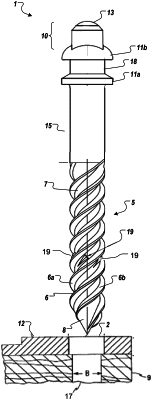| CPC E01B 9/06 (2013.01) [E01B 9/10 (2013.01); E01B 13/02 (2013.01)] | 72 Claims |

|
1. A rail anchoring spike for fastening metal to a tie, comprising:
(a) a head having one or more flanges;
(b) a stand-off extending axially from a bottom flange of said one or more flanges; and
(c) a shank extending axially from said stand-off to form a tapered tip; said shank being adapted to engage said tie; said shank comprising:
i) a plurality of helical, generally parallel threads extending over a threaded portion of said shank and running from said stand-off to said tapered tip; said stand-off having a length adapted to ensure that said threads are fully engaged in said tie when said spike is used to fasten metal to said tie; said threads for engaging said tie at a depth in said tie to ensure engagement with dense material of said tie; and
ii) a plurality of barbs positioned in a lower half of said threaded portion; each of said barbs: (1) having a starting point and a barb body extending along a length from said starting point to a barbed end that has a substantially triangular cross-sectional shape, and (2) being positioned substantially centrally in a valley defined between a pair of threads and configured to minimize damage to fibers of said tie during installation of said spike as fibers of said tie relax behind and engage with said barbed end of said barb to prevent movement of said spike over time despite deterioration of said tie;
wherein:
said length of said barb body is greater than a maximum width of said substantially triangular cross-sectional shape of said barbed end;
said length of said barb body extends generally parallel to said threads; and
each of said barbs is positioned along said threaded portion such that said barbs contact a lower portion of said tie when said spike is installed in a rail assembly.
|